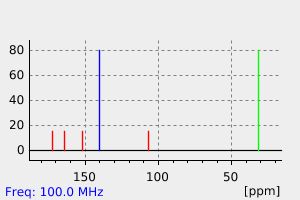(2,4-二氧代-1,2,3,4-四氢嘧啶-5-基)乙酸 | 20763-91-1
中文名称
(2,4-二氧代-1,2,3,4-四氢嘧啶-5-基)乙酸
中文别名
——
英文名称
uracil-5-ylacetic acid
英文别名
2-(2,4-dioxo-1,2,3,4-tetrahydropyrimidin-5-yl)acetic acid;5-carboxymethyluridine;5-Carboxymethyluracil;(2,4-dioxo-1,2,3,4-tetrahydro-pyrimidin-5-yl)-acetic acid;(2,4-Dioxo-1,2,3,4-tetrahydro-pyrimidin-5-yl)-essigsaeure;2-(2,4-dioxo-1H-pyrimidin-5-yl)acetic acid
CAS
20763-91-1
化学式
C6H6N2O4
mdl
MFCD08690197
分子量
170.125
InChiKey
ZVGODTQUYAKZMK-UHFFFAOYSA-N
BEILSTEIN
——
EINECS
——
-
物化性质
-
计算性质
-
ADMET
-
安全信息
-
SDS
-
制备方法与用途
-
上下游信息
-
文献信息
-
表征谱图
-
同类化合物
-
相关功能分类
-
相关结构分类
物化性质
-
熔点:302 °C
-
密度:1.479±0.06 g/cm3(Predicted)
-
溶解度:0.02 M
计算性质
-
辛醇/水分配系数(LogP):-2.1
-
重原子数:12
-
可旋转键数:2
-
环数:1.0
-
sp3杂化的碳原子比例:0.166
-
拓扑面积:95.5
-
氢给体数:3
-
氢受体数:4
安全信息
-
海关编码:2933599090
SDS
上下游信息
-
上游原料
中文名称 英文名称 CAS号 化学式 分子量 (4-羟基-2-疏基嘧啶-5-基)乙酸乙酯 2-Thiouracil-5-essigsaeure-aethylester 29571-39-9 C8H10N2O3S 214.245 -
下游产品
中文名称 英文名称 CAS号 化学式 分子量 —— ethyl 2-(2,4-dioxo-1,2,3,4-tetrahydropyrimidin-5-yl)acetate 29571-46-8 C8H10N2O4 198.178 5-(甲氧基甲基)尿嘧啶 5-methoxymethyluracil 57346-43-7 C6H8N2O3 156.141
反应信息
-
作为反应物:描述:(2,4-二氧代-1,2,3,4-四氢嘧啶-5-基)乙酸 在 三氟甲磺酸三甲基硅酯 作用下, 以 1,2-二氯乙烷 、 xylene 为溶剂, 反应 4.0h, 生成 2',3',5'-tri-O-benzoyl-5-carboxymethyluridine参考文献:名称:Synthesis of Some Hydroxamic Acids Related to Uridine: Potential Inhibitors of Ribonucleoside Diphosphate Reductase摘要:5-(N-Hydroxy)carboxamidouridine (5) and 5-(N-hydroxy)carboxamidomethyluridine (6) have been synthesized; these hydroxamic acids incorporate a radical trap into a nucleoside structure, and are designed as potential inhibitors of ribonucleotide diphosphate reductase.DOI:10.1080/07328319708002527
-
作为产物:描述:alkaline earth salt of/the/ methylsulfuric acid 在 氢碘酸 作用下, 生成 (2,4-二氧代-1,2,3,4-四氢嘧啶-5-基)乙酸参考文献:名称:Johnson; Ambler, Journal of the American Chemical Society, 1911, vol. 33, p. 981摘要:DOI:
文献信息
-
[EN] DIHYDROPYRIMIDINE DERIVATIVES AND USES THEREOF IN THE TREATMENT OF HBV INFECTION OR OF HBV-INDUCED DISEASES<br/>[FR] DÉRIVÉS DE DIHYDROPYRIMIDINE ET LEURS UTILISATIONS DANS LE TRAITEMENT D'UNE INFECTION PAR LE VIRUS DE L'HÉPATITE B OU DE MALADIES INDUITES PAR LE VIRUS DE L'HÉPATITE B申请人:JANSSEN SCIENCES IRELAND UNLIMITED CO公开号:WO2020001448A1公开(公告)日:2020-01-02The application describes dihydropyrimidine derivatives which are useful in the treatment or prevention of HBV infection or of HBV-induced diseases, more particularly of HBV chronic infection or of diseases induced by HBV chronic infection, as well as pharmaceutical or medical applications thereof.
-
Peptide nucleic acids申请人:ISIS Pharmaceuticals, Inc.公开号:US06451968B1公开(公告)日:2002-09-17Novel peptide nucleic acids and novel linked peptide nucleic acids, form triple stranded structures with nucleic acids. The peptide nucleic acids include ligands such as naturally occurring nucleobases attached to a peptide backbone through a suitable linker. Other nucleobases including C-pyrimidines and iso-pyrimidines can be used as the ligands in Hoogsteen strands to increase binding affinity. Two peptide nucleic acid strands are joined together with a linker to form a bis-peptide nucleic acid. The individual strands of the peptide nucleic acids in the bis compounds can be orientated either parallel or antiparallel to each other.
-
[EN] COMPOUNDS AND COMPOSITIONS FOR INTRACELLULAR DELIVERY OF AGENTS<br/>[FR] COMPOSÉS ET COMPOSITIONS POUR L'ADMINISTRATION INTRACELLULAIRE D'AGENTS申请人:MODERNATX INC公开号:WO2018232120A1公开(公告)日:2018-12-20The disclosure features amino lipids and compositions involving the same. Nanoparticle compositions include an amino lipid as well as additional lipids such as phospholipids, structural lipids, PEG lipids, or a combination thereof. Nanoparticle compositions further including therapeutic and/or prophylactic agents such as RNA are useful in the delivery of therapeutic and/or prophylactic agents to mammalian cells or organs to, for example, regulate polypeptide, protein, or gene expression.
-
Linked peptide nucleic acids申请人:ISIS Pharmaceuticals, Inc.公开号:US06441130B1公开(公告)日:2002-08-27Novel peptide nucleic acids and novel linked peptide nucleic acids, form triple stranded structures with nucleic acids. The peptide nucleic acids include ligands such as naturally occurring nucleobases attached to the peptide backbone through a suitable linker. Other nucleobases including C-pyrimidines and iso-pyrimidines can be used as the ligands in Hoogsteen strands to increase binding affinity. Two peptide nucleic acid strands are joined together with a linker to form a bis-peptide nucleic acid. The individual strands of the peptide nucleic acids in the bis compounds can be oriented either parallel or antiparallel to each other.
-
Design of Bivalent Nucleic Acid Ligands for Recognition of RNA-Repeated Expansion Associated with Huntington’s Disease作者:Shivaji A. Thadke、J. Dinithi R. Perera、V. M. Hridya、Kirti Bhatt、Ashif Y. Shaikh、Wei-Che Hsieh、Mengshen Chen、Chakicherla Gayathri、Roberto R. Gil、Gordon S. Rule、Arnab Mukherjee、Charles A. Thornton、Danith H. LyDOI:10.1021/acs.biochem.8b00062日期:2018.4.10they undergo template-directed native chemical ligation to form concatenated oligomeric products that bind tightly to the RNA template. In the absence of an RNA target, they self-deactivate by undergoing an intramolecular reaction to form cyclic products, rendering them inactive for further binding. The work has implications for the design of ultrashort nucleic acid ligands for targeting rCAG-repeat expansion
表征谱图
-
氢谱1HNMR
-
质谱MS
-
碳谱13CNMR
-
红外IR
-
拉曼Raman
-
峰位数据
-
峰位匹配
-
表征信息
同类化合物
(S)-3-(2-(二氟甲基)吡啶-4-基)-7-氟-3-(3-(嘧啶-5-基)苯基)-3H-异吲哚-1-胺
(6-羟基嘧啶-4-基)乙酸
(4,5-二甲氧基-1,2,3,6-四氢哒嗪)
鲁匹替丁
马西替坦杂质7
马西替坦杂质4
马西替坦杂质
马西替坦原料药杂质D
马西替坦原料药杂质B
马西替坦
顺式-4-{[5-溴-2-(2,5-二甲基-1H-吡咯-1-基)-6-甲基嘧啶-4-基]氨基}环己醇
非沙比妥
非巴氨酯
非尼啶醇
青鲜素钾盐
雷特格韦钾盐
雷特格韦相关化合物E(USP)
雷特格韦杂质8
雷特格韦EP杂质H
雷特格韦-RT9
雷特格韦
阿西莫司杂质3
阿西莫司
阿脲四水合物
阿脲一水合物
阿维霉素
阿米美啶
阿米洛利
阿米妥钠
阿洛巴比妥
阿普瑞西他滨
阿普比妥
阿巴卡韦相关化合物B(USP)
阿卡明
阿伐那非杂质V
阿伐那非杂质1
阿伐那非杂质
阿伐那非中间体
阿伐那非
铂(2+)二氯化6-甲基-1,3-二{2-[(2-甲基丙基)硫烷基]乙基}嘧啶-2,4(1H,3H)-二酮(1:1)
钴1,2,3,6-四氢-2,6-二氧代嘧啶-4-羧酸酯(1:2)
钠5-烯丙基-4,6-二氧代-1,4,5,6-四氢-2-嘧啶醇酸酯
钠5-乙基-4,6-二氧代-1,4,5,6-四氢-2-嘧啶醇酸酯
钠5-(2-溴丙-2-烯基)-5-丁烷-2-基-4,6-二氧代-1H-嘧啶-2-醇
醌肟腙
酒石酸噻吩嘧啶
那可比妥
辛基2,6-二氧代-1,2,3,6-四氢-4-嘧啶羧酸酯
赛乐西帕杂质3
赛乐西帕KSM3







